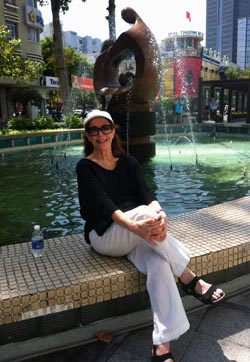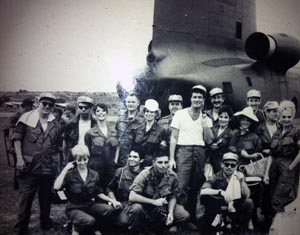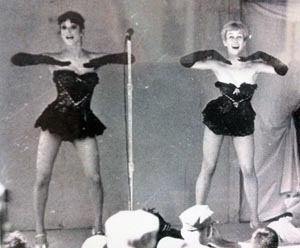 |
Vietnam: A Time CapsuleBy Suzanne Cogan
In 1967 I was a singer-dancer in a USO tour of "Guys and Dolls," starring Hugh O'Brian. When I flew into Danang I saw a nearly deserted city bisected by a dirty river. The military air base was on one shore, the VIP (and only) hotel plus some run-down buildings on the other. We were ferried across the river on an open barge. A few days later we heard that our hotel had been bombed. We shrugged and joked about it, hey, we were young. Nothing could happen to us. This February I re-visited Vietnam as a tourist with a small group, traveling from Saigon and the Mekong Delta to Dalat, Nha Trang, Hué, Hoi An, Hanoi, Halong Bay and Danang. But — where was it? No trace of the former city remained except the river, now spanned by an impressive, newly constructed bridge. On either shore were high-rise apartments, newly constructed office buildings, and countless streets, shops, restaurants, a thriving, successful city. When I tried to superimpose memory onto the current image, it was out of focus. Was my memory real? In my mind's eye it definitely was. Then how to reconcile the remembered past with the obvious, visible present? Could they be different and still, in a strange way, the same? These questions haunted me throughout my entire visit. In Saigon, now Ho Chi Minh City (HCMC), I searched for familiar places. I'd checked the internet but found no trace of our former hotel, the Meyerkord. I believe it was located on Tu Do Street (Rue Catinat under the French, Dong Khoi today), somewhere in the French colonial neighborhood past the Post Office and Cathedral. The Rex Hotel still existed, but it had been totally modernized. The Continental Hotel and open square in front of the Opera House, both featured in "The Quiet American," felt as real as anything I'd actually experienced. I was struck by the extreme contrast of wealth (5-star hotels, international boutiques) and poverty (beggars, locals squatting or sitting on plastic stools selling cheap items) and a tsunami of motorcycles, bicycles, cars, and cyclos that swerved and honked at pedestrians trying to cross the street. The survival technique (HCMC and Hanoi) — take a deep breath, walk slowly and steadily through the insane traffic, keep your eyes focused straight ahead. If you stop or turn your head you risk an accident! At first it was terrifying, but then I began to enjoy it! It felt like skiing downhill in a blizzard.
In Nha Trang, the country's most popular beach resort. I remembered taking a delightful swim in the South China Sea (renamed "East Sea" by the Vietnamese). I'd seen broken cabanas, dirty sand, and - nothing. Just the sea, the blue sky, a few puffy white clouds. I recalled floating on my back, wondering how it was possible that a War was being fought only a few miles away. Everything seemed so peaceful, beautiful, perfect. Today it resembles any affluent beach resort. Havana, Cancun, Miami, the Riviera — take your pick. A phalanx of luxury hotels, many flashing neon signs, overlook the pristine beach. Brightly colored flowers and palm trees separate the road from the thatched roof bars and umbrellas that dot the white sand. Our hotel featured signs in Vietnamese, English, and Russian. There are direct flights from Moscow to Nha Trang, a favorite resort of nouveau riche Russians. I enjoyed visiting places that were off-limits during the War, especially Hanoi, a fast-paced, modern city, and Hu?, the imperial capital that was almost destroyed in 1965. I learned that most Vietnamese consider the American War, along with the thousand-year Chinese occupation and French colonial period (1867 to 1954) as history. Past. Over. I was impressed by their spirit and resilience, as well as a deep love for their land. The Vietnamese I spoke with feel optimistic and are working towards a prosperous future. Even the masses of yellow flowers that celebrate the Lunar New Year (Tet) symbolize prosperity and good fortune. I have one memory that has no counterpart in the present. During hospital visits we were told NEVER to mention the War, but, to speak about home towns, sports teams, anything to build morale. I will never forget one baby-faced soldier with carrot red hair, pale freckled skin, and enormous green eyes. When I approached his bed he grabbed my hand, "Ma'am, can you help me?" he pleaded. "Ah've been sick ever since ah got here. First they sent me to the Delta but ah got malaria so they brung me here and ah got better so they sent me back down but ah got malaria again so they brung me back and it keeps on happenin' so please Ma'am, can you help me? Ah just want to go home." I hope he made it. Suzanne Cogan toured VIetnam in "Guys and Dolls" for the USO. She danced on French TV and off-Broadway and sang soprano at the Metropolitan Opera. Her plays have been produced in NY and LA. She is married and lives in New York, where she is co-producing a musical.
|




